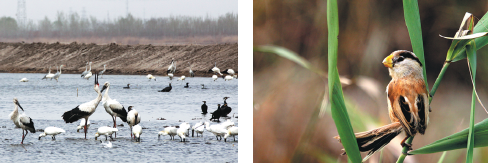A wetland flooded with migrating birds

China's top wetlands expert, Zhang Zhengwang, regularly brings international researchers, volunteers and photographers to the Beidagang Wetland in coastal Tianjin municipality.
The 60-year-old professor at Beijing Normal University's Life Sciences School leads them to study the ecology, especially the bird species, and protection.
"We visit frequently to investigate and record information for databases and for the wetland's bid for a UNESCO World Natural Heritage listing in 2022," he says.
Zhang says the research shows that the Beidagang Wetland has surpassed most standards required for the listing.
Tianjin is an important stopover on one of the eight major bird-migration routes from South Asia to Australia, and many species rest in Beidagang's coastal area before flying to Australia or New Zealand.
The birds will return to Tianjin on their northward migrations that go as far as the North Pole.
"The wetland is essential for the birds' breeding and growth. Without it, they may be in danger during their migrations," Zhang says.
Beidagang Wetland Management Center deputy director Sun Baonian says they've made concrete efforts to improve rare-bird protection in recent years.
A total of 1,347 Oriental storks have been identified in the wetlands, accounting for nearly 45 percent of the species' global migration population, he says. They prefer to nest in high trees and buildings.
Since Beidagang doesn't have enough high trees, the center has set up 20 artificial nesting areas on poles, 13 of which have been used by the waterfowl. And 17 chicks were born in the wetlands late last year.
The center also offers "homes" for volunteers and tourists, who come to learn more about wetland protection and enhance their awareness about how to protect the wetlands and birds.
Wen Cheng, a member of the UNESCO World Heritage application committee under the National Forestry and Grassland Administration, says Beidagang will join the application of the Yellow and Bohai Seas' migratory-bird project.
Wen points out that the project has been supported by the International Union for Conservation of Nature since 2012, following a highlevel meeting in South Korea.
In 2016, the IUCN encouraged China to apply for UNESCO status for the sites. A growing number of international organizations have since expressed support.
Beidagang hosts 70 percent of the world's endangered Central Asian gulls.
A total of 276 avian species, including 11 under national protection, use the wetland.
The population of each species in Beidagang exceeds 1 percent of the global total, researchers say.
Tianjin was once the Yellow River's estuary. An ancient shell dam on the coastline may reveal the ancient sea's development.
"All these facts meet UNESCO's criteria," Wen says.
Beidagang Wetland covers nearly 350 square kilometers, including a core area of about 115 sq km, in the southeast of the Binhai New Area.
The city has released a comprehensive plan for the wetlands' protection from 2018 to 2021.
In 2019, the Binhai New Area reclaimed over 77 sq km of fishing areas as wetlands. It also reclaimed nearly 9 sq km of farmland, and relocated 10 enterprises and 24 families.
Shang Chenghai, deputy director of the reserve's administrative committee, says the water reserve has increased to 379 million cubic meters, and the wetland area has increased from 140 sq km to 240 sq km in the last two years.

Today's Top News
- Lawmakers review draft law to expand childcare services
- China's new-style tea brands find a hot new market in US
- Xi extends congratulations to Chilean president-elect
- Japan urged to stop provocative moves
- Shanxi ends province-wide blanket fireworks ban
- Tech park set to lift GBA's development






























